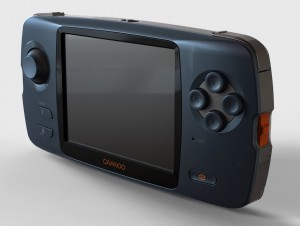Maximum Letdown: GP2X Caanoo (Handheld Game System)
by William Talley, filed in Articles, Maximum Letdown on Oct.08, 2013

This past weekend saw the news that the Neo Geo X would cease production. With that note, it brings to mind another handheld which had an all-too-brief existence, Gamepark Holdings’ GP2X Caanoo. What’s that you say? Never heard of it? Well, that’s part of the reason it didn’t last long. Normally, Maximum Letdown takes potshots at bad games or/hardware. However, this Maximum Letdown is a letdown of a different variety, because the product had some potential, it just succumbed to poor timing and poor marketing.
Gamepark Holdings was a South Korean company made up of former employees of Gamepark, a company that itself went under in 2007. Gamepark was founded in 1996, and in 2002, the company released the Gamepark 32-bit, South Korea’s first handheld system. Although it was only released in Korea, it had a small following among importers due to it’s open source architecture, which allowed homebrew and independent developers to create software for it. After it’s success, several employees split off from the company after a disagreement on which direction to take the company. While Gamepark wanted to release a more 3D oriented system i.e Sony’s PSP, the dissenting employees, among them being most of the company’s engineers, envisioned a more Game Boy Advance-like 2D device that stuck to its open source roots. These employees formed Gamepark Holdings, and released the wildly successful (well in Korea anyway) GP2X. The company re-upped in 2009 with the GP2X Wiz. Gamepark itself meanwhile went out of business in 2007, and plans to make a casual-gamer-friendly handheld called the XGP fell through. GamePark Holdings’ GP2X Caanoo, released in 2011 is the successor to the Wiz and would end up being the last handheld that Gamepark Holdings would produce.
The Caanoo runs on a form of linux, and packs a touch screen, gyroscopic sensor, a USB port, and an SD card slot. WiFi play is possible by use of a USB dongle that the company sold. Its button layout consists of 4 face buttons, two shoulder buttons, two menu buttons, and an analog thumb stick. There is no internal memory, so you’ll need an SD card to store files. The unit packs a text e-reader, music, and video players. While the touch screen isn’t as advanced as a Nintendo DS or even your android phone, it’s still there and homebrewers have made applications that make use of it. It’s as if the engineers wanted to pack as many options on the system as possible for homebrew developers while still keeping it at an acceptable price. At the time of its release, the Caanoo carried a price tag of approximately $150 in U.S dollars. Although it was only sold in South Korea and parts of Europe, you could American gamers could obtain it at any import store. In fact I got mine from play-asia.com for only $175, including shipping. Of course, since it does come from Korea, you’re pretty much screwed when it comes to tech support. And what’s with the shape of the synch cable?
GPH tried to implement an itunes-style downloadable games service a’la the Xbox Live market place. There were some free titles on it as well. Unfortunately, U.S owners of the system were unable to buy the currency to purchase titles, and getting the desktop app to download titles properly involved hacking the system files. Thankfully homebrewers provided several titles of their own, including a Doom source port, a tower defense game, a Puzzle Quest clone, and ports of Beats of Rage and Tyrian. You can still download them from the openhandhelds site. Of course, what good would any open source system (or closed source) be without software emulators? You can find some good SNES, NES, Genesis, and even Arcade emulators.
In the end, the Caanoo was a victim of poor timing. If it had been released in say, 2006, and had a wider American release, then it could have easily provided a new area of the gaming market. Sadly, at the time of its release, both Android and iOS were taking off. GamePark Holdings would fold in 2012 with little fanfare, and the Caanoo would disappear with it. Shame too, as open source system handhelds like the Caanoo could find a bigger audience with the emerging independent game scene. Fortunately, its spirit lives on with the recently released Ouya.


 PS3
PS3
 Famicom Dojo
Famicom Dojo KEEP PLAYING
KEEP PLAYING KEEP PLAYING: Rewind
KEEP PLAYING: Rewind Powet Toys
Powet Toys Powetcast
Powetcast Hitchhiker's Guide POWETcast
Hitchhiker's Guide POWETcast














